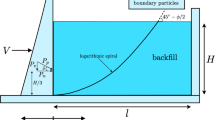Abstract
— A bonded-particle model is used to simulate shear-type microseismic events induced by tunnel excavation in granite. The model represents a volume of granite by an assembly of 50,000 individual particles bonded together at points of contact. A plane of weakness is included in the model and this plane is subjected to increasing shear load while the normal load across the plane is held constant. As shear stress in the model increases, bonds begin to break and small acoustic emissions (AE) result. After enough bonds have broken, macro-slip occurs across the large portions of the fault in an unstable manner. Since the model is run dynamically, seismic source information can be calculated for the simulated AE and macro-slip events. This information is compared with actual results obtained from seismic monitoring around an underground excavation. Although the modelled events exhibit larger magnitudes than the actual recorded events, there are many similarities between the model and the actual results, namely the presence of foreshocks before the macro-slip events and the patterns of energy release during loading. In particular, the model provides the ability to examine the complexity of the slip events in detail.
Similar content being viewed by others
Author information
Authors and Affiliations
Additional information
(Received April 4, 2000, revised/accepted August 10, 2000)
Rights and permissions
About this article
Cite this article
Hazzard, J., Collins, D., Pettitt, W. et al. Simulation of Unstable Fault Slip in Granite Using a Bonded-particle Model. Pure appl. geophys. 159, 221–245 (2002). https://doi.org/10.1007/PL00001252
Issue Date:
DOI: https://doi.org/10.1007/PL00001252




